Animals
Understanding How Fish Mate | Marine Reproduction Secrets
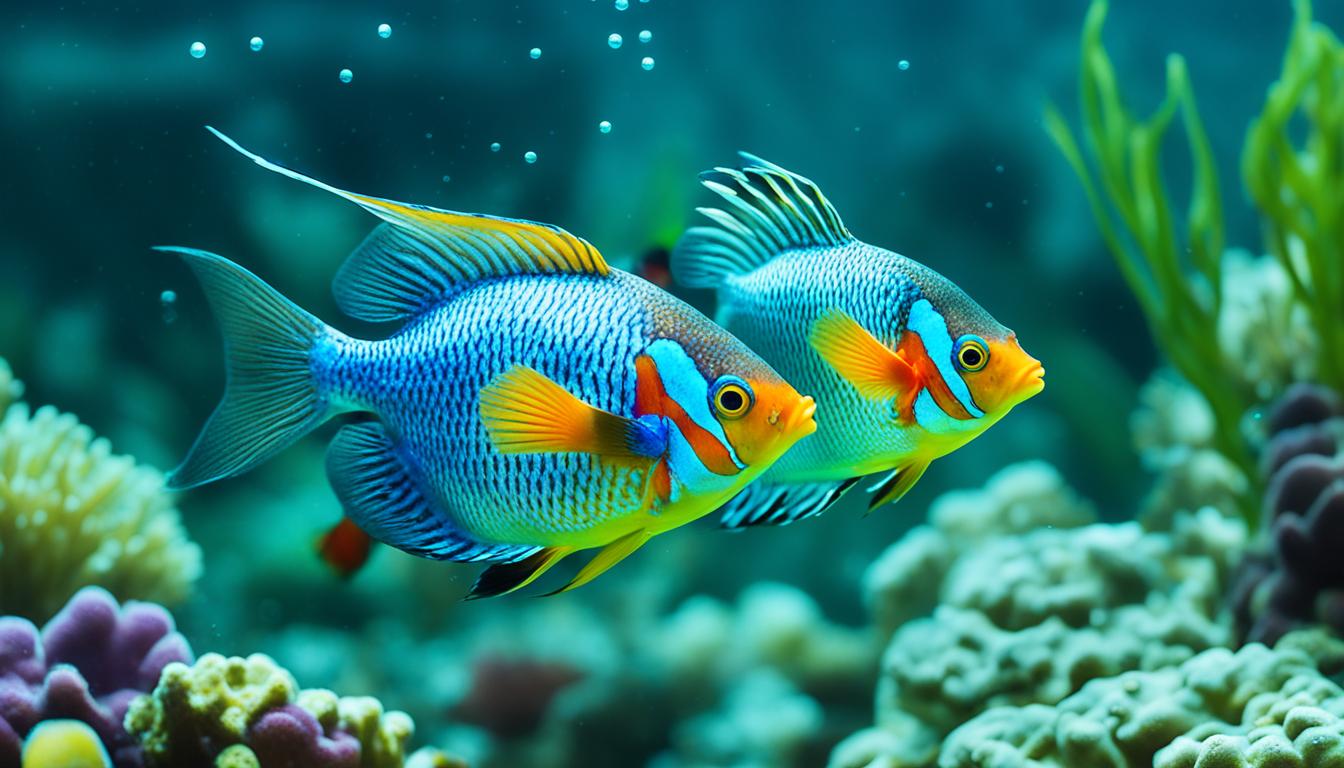
Fish, the most diverse vertebrate species on the planet, have a fascinating and complex mating system. Did you know that there are over 32,000 known species of fish, each with their own unique reproductive anatomy and mating behaviors? From external fertilization to internal fertilization, fish have evolved a myriad of strategies to ensure the continuation of their species. Join us as we dive into the world of fish reproduction and uncover the secrets of marine mating rituals.
Key Takeaways
- Fish reproduction is incredibly diverse, with over 32,000 species each exhibiting unique mating behaviors.
- Fish can reproduce through external fertilization, internal fertilization, mouthbrooding, ovoviviparity, or viviparity.
- Mating strategies among fish include promiscuity, polygamy, monogamy, and hermaphroditism.
- Fish reach sexual maturity at different ages, and their spawning frequency varies greatly.
- Understanding fish reproduction is crucial for conservation efforts and maintaining the biodiversity of marine ecosystems.
The Reproductive Anatomy of Fish
Fish have reproductive anatomy similar to other vertebrates. Most fish species have separate sexes, with males having testes and females having ovaries. However, some fish are hermaphrodites and possess both male and female reproductive organs. Fish reproduction requires the fusion of eggs and sperm, and there are various ways in which this can occur. Understanding the reproductive anatomy of fish is essential in unraveling the mysteries of their mating habits.
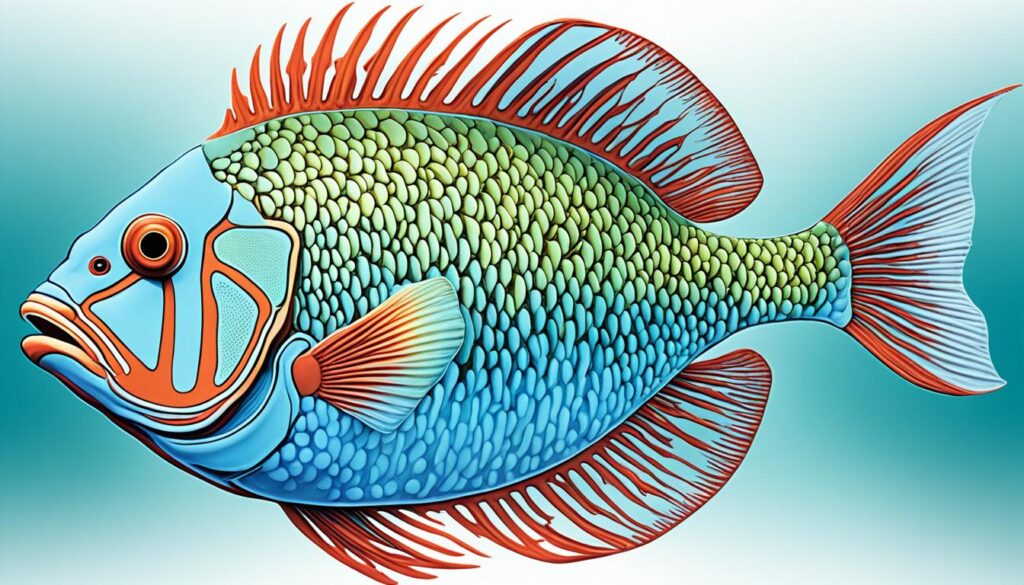
| Fish Reproductive Anatomy | Description |
|---|---|
| Male reproductive organs | Testes |
| Female reproductive organs | Ovaries |
| Hermaphrodite fish | Have both male and female reproductive organs |
The reproductive anatomy of fish plays a crucial role in their ability to reproduce and pass on their genetic material. Males produce sperm in their testes, while females produce eggs in their ovaries. The sperm and eggs are released during the process of spawning, where they come into contact and fertilization occurs. This fusion of gametes leads to the development of new individuals.
Different Ways in Which Fish Mate
Fish employ various strategies and behaviors when it comes to mating, showcasing the incredible diversity in their reproductive methods. Understanding these different mating methods is key to appreciating the complexity of fish reproduction.
1. External Fertilization: Oviparous fish, such as salmon and trout, lay their eggs in the water. Males release sperm over the eggs, fertilizing them externally. This method allows for a large number of eggs to be produced, increasing the chances of successful reproduction.
2. Mouthbrooding: Some fish species, like certain cichlids and gobies, practice mouthbrooding. In this behavior, the female carries the fertilized eggs in her mouth until they hatch. Mouthbrooding provides better protection for the developing embryos, as the female can keep them safe from predators.
3. Internal Fertilization: Fish that practice internal fertilization, such as many species of sharks and rays, have specialized reproductive organs. Males use claspers to transfer sperm into the female’s reproductive tract. This method ensures direct fertilization and increases the chances of successful reproduction.
4. Ovoviviparity and Viviparity: There are fish species that carry their eggs or embryos inside their bodies until they give live birth. Ovoviviparous fish retain the fertilized eggs, while viviparous fish provide nutrients to the developing embryos through a placenta-like structure. This reproductive strategy provides added protection and increases the chances of survival for the offspring.
By examining the various mating behaviors and reproductive strategies of fish, we gain a deeper understanding of their remarkable adaptation to different environments and ecological niches.
Exploring the Intricate World of Fish Reproduction
Let us now delve deeper into the fascinating world of fish reproduction and explore the incredible diversity of mating strategies and behaviors.
Mating Strategies and Behaviors
Fish exhibit a wide range of mating strategies and behaviors that contribute to their remarkable diversity. These strategies provide insights into the complexities of fish reproduction and shed light on their unique reproductive adaptations.
Promiscuity is a prevalent mating system in fish, where both males and females engage in breeding with multiple partners. This approach ensures a diverse genetic pool and increases the chances of successful reproduction.
Polygamy, including polygyny (one male with multiple females) and polyandry (one female with multiple males), is another mating strategy observed in fish. This behavior allows certain individuals to dominate mating opportunities and maximize their reproductive success.
While polygamy is common, monogamy is relatively rare in fish. Monogamous mating involves the formation of lifelong pair bonds between partners. This strategy promotes cooperation for tasks such as defending territories or caring for offspring. Some of the few monogamous fish species include the seahorse and the California sheephead.
Some fish take mating strategies to a whole new level with hermaphroditism. These species possess the remarkable ability to produce both eggs and sperm. Depending on the circumstances, hermaphroditic fish can change their sex, ensuring reproductive flexibility and adapting to environmental conditions.
| Mating Strategy | Description |
|---|---|
| Promiscuity | Both males and females mate with multiple partners to increase genetic diversity. |
| Polygamy | Includes polygyny (one male with multiple females) and polyandry (one female with multiple males) for enhanced reproductive success. |
| Monogamy | Forming lifelong pair bonds between partners for cooperative tasks and shared parental care. |
| Hermaphroditism | Ability to change sex or simultaneous production of eggs and sperm, providing reproductive flexibility. |
Fish mating strategies are essential in maintaining species diversity and promoting the survival of different populations. By studying these behaviors, researchers and enthusiasts gain a deeper appreciation for the intricacies of fish reproduction and its role in shaping marine ecosystems.

Sexual Maturity and Spawning Frequency
Understanding the sexual maturity and spawning cycles of fish is crucial for responsible fishing and conservation efforts. The age at which fish reach sexual maturity varies across species, and it is influenced by factors such as size, age, and environmental conditions. Smaller adult fish tend to reach maturity earlier.
Spawning frequency also varies among fish species, with some capable of reproducing multiple times throughout their lives, while others reproduce only once and die shortly after. This information helps us understand the reproductive capabilities and breeding patterns of different fish species.
To illustrate this, let’s take a look at some examples of fish sexual maturity and spawning cycles:
| Fish Species | Sexual Maturity | Spawning Frequency |
|---|---|---|
| Salmon | 3-4 years | Once in their lifetime |
| Clownfish | 6-12 months | Multiple times a year |
| Tuna | 2-5 years | Multiple times a year |
| Guppy | 2-3 months | Continuously throughout their lives |
As you can see, fish species have diverse sexual maturity and spawning patterns. Understanding these factors helps us make informed decisions in managing fish populations and implementing effective conservation measures.

“Understanding the sexual maturity and spawning cycles of fish is crucial for responsible fishing and conservation efforts.”
Protecting Fish Breeding Seasons
By being aware of fish breeding seasons, we can take steps to protect important habitats and ensure the successful reproduction of fish species. Different fish species have specific times of the year when they spawn, and these periods are critical for their survival.
For example, many migratory fish species, such as salmon, undertake long journeys to reach their spawning grounds. Protecting these natural breeding habitats and maintaining healthy river ecosystems is essential for their reproductive success.
Furthermore, regulations and fishing restrictions can be implemented during fish breeding seasons to prevent overfishing and ensure the sustainability of fish populations.
By understanding the sexual maturity, spawning cycles, and fish breeding seasons, we can contribute to the conservation and preservation of fish species for future generations.
Conclusion
Fish reproduction is an intriguing subject characterized by a wide range of mating behaviors, reproductive strategies, and spawning rituals. Exploring how fish mate is not only fascinating for enthusiasts and researchers but also vital for conservation efforts. It allows us to gain a deeper appreciation for the incredible biodiversity and sustainability of marine ecosystems.
Throughout this article, we have delved into the intricacies of fish reproduction, uncovering the various ways in which fish mate. We have learned about their reproductive anatomy, from the separate sexes to the hermaphrodite fish. We have also explored different mating strategies, such as monogamy, polygamy, and promiscuity. Additionally, we have examined the sexual maturity and spawning frequency of fish, shedding light on their breeding habits.
By understanding the secrets of fish reproduction, we can contribute to the conservation and preservation of these remarkable species. It is essential to protect marine reproductive diversity to ensure the continuation of fish populations and the stability of our ecosystems. Let’s continue exploring and appreciating the wonders of marine reproduction, working together to safeguard the future of these fascinating creatures.
FAQ
Why is understanding how fish mate important?
What are the reproductive anatomy of fish?
What are the different ways in which fish mate?
What are some mating strategies and behaviors of fish?
At what age do fish reach sexual maturity?
How often do fish reproduce?
Dana is our Lead Content Writer, bringing a wealth of knowledge and expertise to our team. With a background deeply rooted in animal studies and a profound love for all creatures, Dana is dedicated to crafting engaging and informative content that resonates with our audience. With Dana at the helm, you can trust that our content is accurate and engaging, catering to the diverse interests of animal enthusiasts everywhere.
Animals
10 Animals Working Hard in the Wild
Meet incredible animals like honeybees, emperor penguins, and earthworms showcasing hard work and dedication in the wild – their stories will inspire you to learn more.

In the wild, animals like honeybees, emperor penguins, earthworms, termites, and more showcase incredible dedication and hard work to survive and thrive in their natural habitats. Honeybees have specific roles based on age, with younger bees handling duties inside the hive and older bees foraging for resources. Emperor Penguins display remarkable parenting skills and teamwork in extreme conditions. Earthworms aerate the earth and enrich soil with essential nutrients. Termites build intricate mounds and maintain consistent internal temperatures. Each of these animals plays a crucial role in their ecosystems, contributing to the balance and diversity of wildlife.
Key Takeaways
- Bees carry loads 60% their weight, forage, and have specific roles based on age.
- Termites build intricate mounds, recycle nutrients, and divide labor among different castes.
- Ants demonstrate incredible strength, efficient communication, and adaptability to various environments.
- Emperor penguins exhibit remarkable teamwork, innovative incubation, and strategic feeding in extreme conditions.
- Earthworms aerate soil, enrich it with nutrients, improve water retention, and recycle organic matter into nutrient-rich castings.
Honeybees
Working tirelessly in their highly organized society, honeybees perform a myriad of tasks essential for the survival and productivity of their hive. Each bee has a specific role based on age, with younger bees handling duties inside the hive, such as caring for the queen and larvae, while older bees venture out for nectar and pollen.
By collaborating, honeybees guarantee the smooth functioning of their community. Notably, these tiny creatures can carry loads equivalent to about 60% of their body weight while foraging for resources. This impressive feat showcases their strength and efficiency in gathering materials for honey production and pollination.
The division of labor among honeybees is pivotal for the overall success of the colony, with every individual contributing to the collective goal of sustaining the hive. Through their diligent efforts and coordinated actions, honeybees exemplify the power of teamwork in achieving remarkable outcomes in nature.
Emperor Penguins

Emperor Penguins are incredible creatures that exhibit efficient parenting skills in the harsh Antarctic environment. These penguins take turns caring for the chick and incubating the egg, showcasing remarkable teamwork in extreme conditions.
The male penguin's dedication is evident as it fasts for about 115 days while diligently looking after the chick, highlighting their exceptional survival strategies.
Efficient Penguin Parenting
During the harsh Antarctic winter, male and female Emperor Penguins exhibit extraordinary dedication in safeguarding their chick. They endure extreme conditions to guarantee their chick's survival, showcasing remarkable teamwork. Here's a closer look at their efficient parenting:
- Innovative Incubation: Both parents take turns incubating the egg in freezing temperatures.
- Strategic Feeding: Male penguins fast for around 115 days while caring for the chick.
- Adaptive Parenting: Emperor Penguins adapt to harsh weather conditions to protect their young.
- Dedicated Duo: Male penguins care for the chick until the female returns with food.
- Survival Tactics: Emperor Penguins show resilience in sustaining themselves and their offspring amid challenges like deep water and medical conditions.
Extreme Antarctic Survival
Enduring harsh conditions and relentless hunger, male Emperor Penguins in Antarctica showcase remarkable dedication in caring for their chicks during the brutal winter months. These incredible animals fast for up to 115 days, traveling long distances of up to 100 miles over treacherous icy terrain to reach open water for food. The temperature in Emperor Penguin colonies can plummet to a bone-chilling -40 degrees Celsius, testing their resilience to the extreme. Despite these challenges, Emperor Penguins exhibit exceptional survival skills, with males taking turns keeping the egg warm on their feet while their partners hunt for sustenance. Their ability to endure such harsh conditions and provide for their young showcases the true spirit of dedication and perseverance in the wild.
| Survival Fact | Description |
|---|---|
| Fasting Period | Up to 115 days without food during harsh winter months |
| Travel Distance for Food | Journey up to 100 miles to reach open water for sustenance |
| Extreme Temperature Range | Enduring temperatures as low as -40 degrees Celsius in their colonies |
Teamwork in Harsh Conditions
Venturing into the icy wilderness of Antarctica, the teamwork displayed by male Emperor Penguins in caring for their chicks under extreme conditions is truly awe-inspiring. These penguins endure harsh Antarctic elements, showcasing remarkable dedication. Here's what makes their teamwork stand out:
- Male penguins brave extreme cold and darkness to care for chicks.
- Both parents take turns protecting and warming the chick.
- The male penguin fasts for months, relying on stored body fat.
- Emperor penguins cooperate diligently in their parenting roles.
- Their teamwork exemplifies resilience and unity in challenging environments.
Earthworms
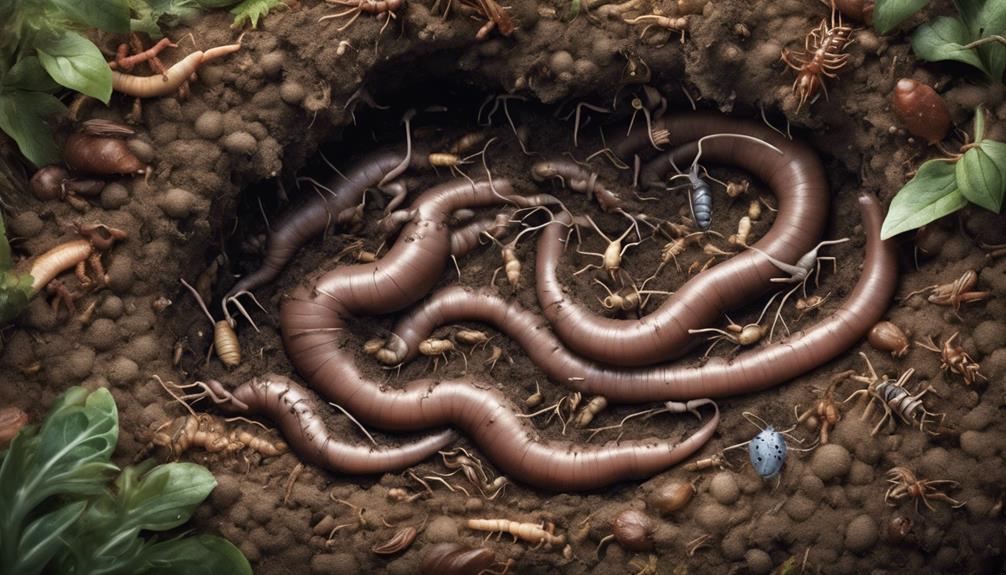
Burrowing tirelessly through the soil, earthworms play an important role in enhancing the ecosystem's vitality by aerating the earth and enriching it with essential nutrients. These remarkable creatures create intricate tunnels as they move, which not only aerates the soil but also improves its water retention capacity. By doing so, earthworms facilitate the penetration of plant roots deeper into the ground, allowing them to access essential nutrients necessary for their growth and development.
Moreover, earthworms are nature's recyclers, consuming organic matter and breaking it down into nutrient-rich castings. These castings are a valuable source of necessary nutrients like nitrogen, phosphorus, and potassium, which are then released back into the soil, enriching it and promoting plant growth. Essentially, earthworms are unsung heroes in the wild, playing an important role in maintaining soil health and fertility within ecosystems.
Termites

Termites are remarkable insects that work diligently to build intricate mounds and maintain their colonies. These tiny creatures play a vital role in the ecosystem by recycling nutrients and creating fertile soil.
Understanding the structure of termite colonies and their role in the environment can provide valuable insights into the complexity of nature.
Termite Mound Construction
Crafting intricate mounds with a mixture of soil, saliva, and excrement, termites demonstrate remarkable architectural prowess in the wild.
- Termites construct strong, durable mounds several meters high with complex tunnel networks for ventilation.
- The design allows for efficient air circulation, maintaining consistent internal temperatures.
- Termite mounds feature chambers for nurseries, food storage, and waste management, showcasing advanced planning.
- These mounds can last for decades or centuries, serving as long-term homes and enhancing ecosystem diversity.
Termite Colony Structure
Within a termite colony, various castes, each with specific duties, work together to guarantee the colony's survival and success. Workers, the most numerous caste, are responsible for tasks like gathering food, caring for the young, and maintaining nest structures.
Soldiers, equipped with large mandibles, protect the colony from threats. The queen, essential for the colony's growth, focuses on laying eggs continuously.
This structured system ensures that termite colonies operate efficiently, demonstrating a high level of organization. By dividing labor among different castes, termites effectively meet the needs of the colony and maintain sustainability.
This intricate social structure plays a significant role in the success and longevity of termite colonies in the wild.
Termite Role in Ecosystem
Playing an important role in ecosystem health, termites contribute greatly to nutrient cycling and soil regeneration through their specialized activities. Here are some key points about the crucial role of termites in the environment:
- Termites consume old wood and convert it into nutrient-rich soil, aiding in soil health and regeneration.
- Termite colonies have specialized roles, with worker termites collecting food, caring for offspring, and building nests.
- These insects play a crucial role in breaking down cellulose, a tough plant material that many other organisms can't digest.
- The activities of termites help recycle nutrients back into the ecosystem, promoting plant growth and biodiversity.
- By decomposing dead plant material, termites contribute to the overall balance and health of the environment they inhabit.
Cleaner Rossies
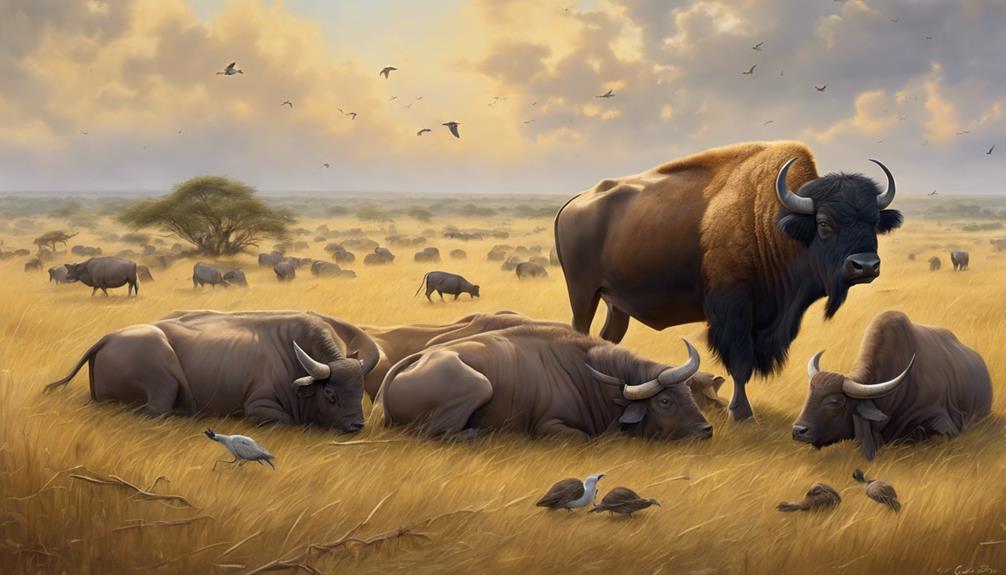
Diligently working day and night, Cleaner Rossies are small fish that play an important role in maintaining the health of coral reefs by removing parasites from other sea creatures. These tiny underwater cleaners tirelessly guarantee the well-being of the marine ecosystem by controlling parasite populations. Their meticulous efforts result in improved overall ecosystem health, showcasing the interconnectedness and symbiotic relationships present in the underwater world.
| Cleaner Rossies | Role |
|---|---|
| Small fish | Eliminate parasites |
| Day and night | Purify reefs |
| Essential for reefs | Sustain balance |
| Enhance ecosystem | Manage parasite populations |
Cleaner Rossies' dedication to their cleaning duties highlights the innovation and efficiency found in nature's design. By actively participating in the health maintenance of coral reefs, these fish demonstrate the importance of every creature's contribution to the ecosystem. Their work serves as a reminder of the intricate web of life beneath the waves, where each organism, no matter how small, plays a critical part in sustaining the beauty and balance of the underwater world.
Koalas

Koalas, the tree-dwelling marsupials famous for their love of eucalyptus leaves, have a unique way of conserving energy. These sleepy yet efficient creatures spend most of their time dozing on branches, sometimes up to 22 hours a day.
Their specialized diet and sedentary lifestyle help them thrive in the wild.
Tree-Dwelling Marsupials
In the wild, the tree-dwelling marsupials known as koalas exhibit a remarkable energy-efficient lifestyle, primarily characterized by their lengthy periods of sleep. Koalas sleep up to 22 hours a day, conserving energy from their low-calorie eucalyptus diet.
These marsupials cling to eucalyptus branches when awake, minimizing movement and maximizing rest. Their energy-efficient approach allows them to thrive with minimal activity, showcasing a unique adaptation for survival.
Despite their extended naps, koalas efficiently manage their energy resources, demonstrating a fine balance between rest and activity in the wild.
Eucalyptus Leaf Eaters
Eating mainly eucalyptus leaves, koalas have evolved a specialized digestion to efficiently extract nutrients from their low-calorie diet. Their digestive system breaks down the tough leaves, allowing them to absorb the limited energy available. This adaptation enables koalas to thrive on a diet that other animals cannot.
By spending most of their time in eucalyptus trees, they conserve energy and stay close to their food source. Koalas have mastered the art of energy efficiency, using their slow metabolic rate and strategic lifestyle.
Their ability to efficiently extract nutrients from eucalyptus leaves showcases the incredible ways animals adapt to their environments.
Sleepy yet Efficient
Amidst their 22-hour slumber, koalas efficiently harness energy from their low-calorie diet by clinging to eucalyptus branches for nourishment. These fascinating marsupials have perfected the art of survival through their unique lifestyle, making them a marvel of nature. Here are some key points to understand the efficiency of koalas:
- Koalas sleep extensively to preserve energy.
- Their diet may be low in calories, but it helps them thrive.
- Clinging to eucalyptus branches allows them to feed efficiently.
- Despite their long naps, koalas manage to gather essential nutrients.
- Energy preservation plays an essential role in the wild for koalas' sustainability.
Sloths
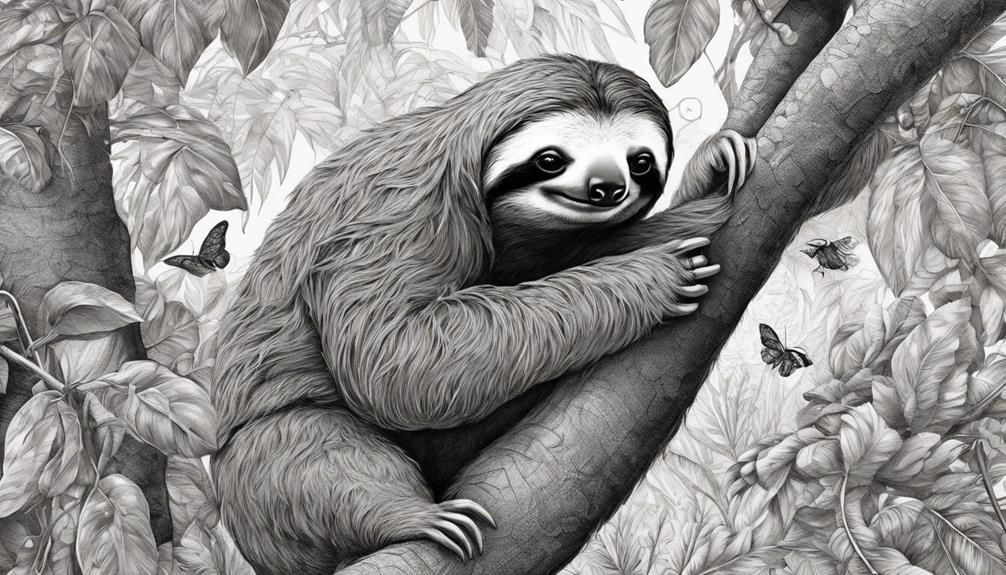
Slowly moving through the treetops, sloths exemplify the art of energy conservation in the animal kingdom. With a remarkably low metabolic rate, sloths can spend 15 to 20 hours per day sleeping. This extended rest period helps them conserve energy, allowing them to thrive on a diet that provides limited energy, such as leaves. Hanging upside down in trees for long periods, sloths have adapted to their environment, where moving slowly isn't a disadvantage but a survival strategy. This slow pace also helps them avoid detection by predators like eagles.
Despite their leisurely lifestyle, sloths are efficient creatures. Their unique adaptations enable them to survive in the wild by conserving energy whenever possible. By understanding the ways in which sloths have evolved to thrive in their habitat, we gain insight into the incredible diversity of strategies that animals employ to succeed in nature.
Pandas

Adapting to a diet with limited energy content, pandas display remarkable dedication by consuming vast quantities of bamboo daily to meet their nutritional requirements. Pandas spend most of their day munching on bamboo, which is low in nutrients but plentiful in their habitat. Here are some fascinating facts about these hardworking bears:
- Pandas have evolved to efficiently extract nutrients from bamboo, making the most of what their diet offers.
- Despite the challenges of a low-energy intake, pandas work diligently to guarantee they meet their dietary needs.
- Survival for pandas hinges on their ability to process and digest bamboo effectively, showcasing their remarkable digestive prowess.
- Their commitment to consuming bamboo showcases their resilience and adaptability to their environment.
- By consuming large amounts of bamboo daily, pandas have developed a unique strategy to thrive in the wild, making them an intriguing species to study.
Tortoises
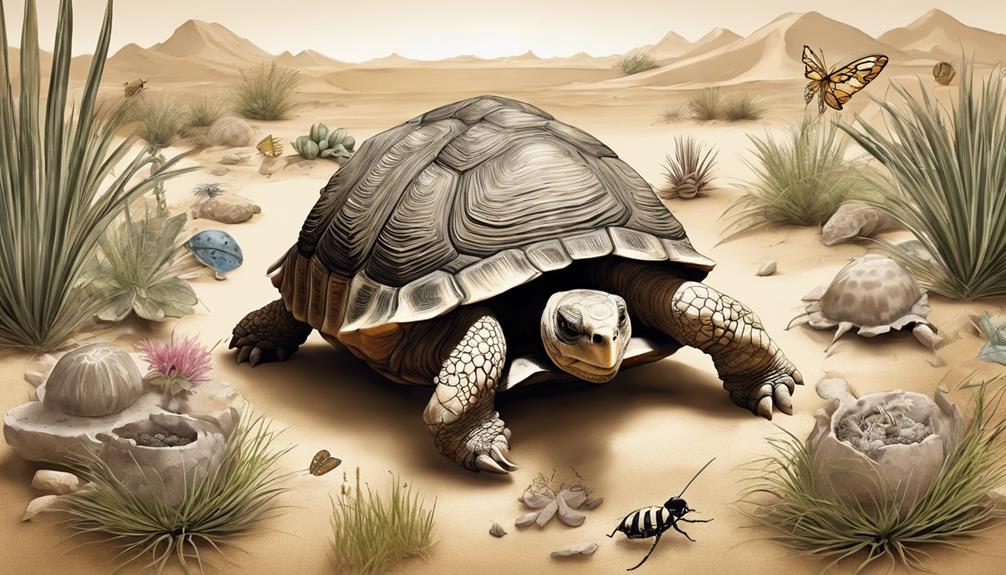
Tortoises, with their heavy protective shells and unique adaptations, play an essential role in their ecosystems. These remarkable creatures move slowly due to their shell's weight, providing them with protection against predators. During harsh conditions, tortoises hibernate for months, conserving energy to survive. Their slow metabolism contributes to their impressive longevity, with some species living for over a century. Tortoises possess a distinctive physiology that enables them to endure extreme temperatures and thrive in diverse habitats.
| Tortoise Facts | |
|---|---|
| 1. Move slowly due to heavy shell | 3. Hibernate for months |
| 2. Long lifespan with slow metabolism | 4. Withstand extreme temperatures |
Despite their leisurely pace, tortoises are vital for their ecosystems. They aid in dispersing seeds and shaping plant communities. By understanding the significance of these unique animals, we can appreciate the intricate balance they bring to the wild.
Ants

Ants demonstrate remarkable strength and efficiency in their collective efforts within highly organized colonies.
- Ants can lift objects 50 times their body weight, showcasing their incredible strength and efficiency in carrying food and building nests.
- Ants work together in highly organized colonies with specialized tasks, such as foraging, caring for young, and defending the nest, to guarantee the survival and success of the group.
- Ants communicate efficiently through the use of pheromones, allowing them to coordinate activities like food gathering, nest construction, and defense effectively.
- Ants play an essential role in ecosystem maintenance by aerating the soil, controlling pests, and recycling organic matter, highlighting their importance in the natural world.
- The industrious nature of ants and their ability to adapt to various environments make them one of the most successful and fascinating insect species in the wild.
These facts about ants reveal their incredible abilities and the pivotal role they play in the ecosystem, showcasing their innovation and adaptability.
Frequently Asked Questions
What Animal Is Hardworking?
I believe the ant exemplifies hard work. Their ability to lift objects 50 times their weight showcases their incredible strength. Their diligence in colony maintenance and foraging demonstrates unparalleled work ethic that inspires admiration.
What Animal Represents Hard Work?
I believe the animal that represents hard work is the honeybee. They tirelessly gather pollen, make honey, regulate hive temperature, and sustain their colony. Their dedication and teamwork exemplify the essence of hard work in nature.
Who Was the Hardest Working Animal on Animal Farm?
I was the hardest working animal on Animal Farm. My motto was 'I will work harder.' Despite my dedication and strength, I was eventually betrayed by the pigs and sent to the glue factory.
Which Animal Is Diligent?
I'm diligent like an ant, endeavoring for success. Hard work propels me forward. I tackle challenges head-on, never backing down. Persistence is my ally, and determination fuels my drive to achieve greatness.
Conclusion
To sum up, these hardworking animals in the wild demonstrate incredible dedication and teamwork to guarantee their survival and success.
From the diligent honeybees to the determined emperor penguins, each species plays an essential role in maintaining the balance of their ecosystems.
It's truly inspiring to see how these animals work together to overcome challenges and thrive in their natural habitats.
By observing and learning from them, we can appreciate the importance of cooperation and perseverance in achieving our own goals.
Dana is our Lead Content Writer, bringing a wealth of knowledge and expertise to our team. With a background deeply rooted in animal studies and a profound love for all creatures, Dana is dedicated to crafting engaging and informative content that resonates with our audience. With Dana at the helm, you can trust that our content is accurate and engaging, catering to the diverse interests of animal enthusiasts everywhere.
Animals
Unique Traits of White Coyote Husky Mixes
Unveil the mysterious and captivating unique traits of White Coyote Husky mixes, leaving you intrigued to discover their extraordinary qualities.
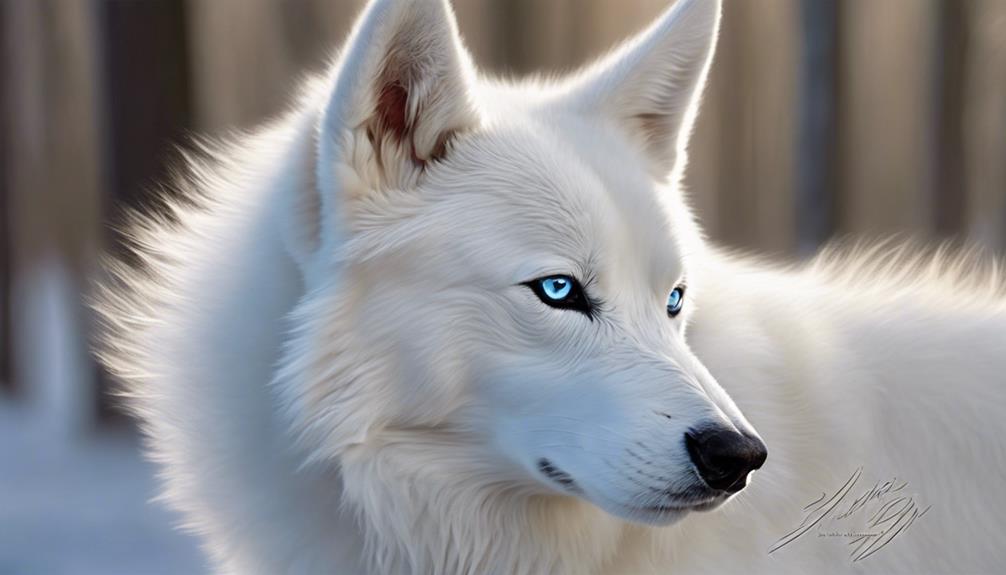
White Coyote Husky mixes are known for their dazzling white coats, unique markings, and mesmerizing blue eyes. They possess an independent nature, loyalty to owners, and a need for early socialization. Their remarkable intelligence, high energy levels, and agile movements make training essential. Regular grooming, consistent training, and secure containment are imperative for their well-being. To socialize them effectively, introduce them to various environments and use positive reinforcement. Patience, tailored routines, and specialized methods are key for overcoming training challenges. Understanding their hybrid lineage complexity is essential. Their unique traits make them fascinating companion animals.
Key Takeaways
- Dazzling white coat colors and unique markings
- High intelligence with problem-solving skills
- Boundless energy levels and need for exercise
- Independent nature requiring firm training
- Importance of early socialization for loyalty
Physical Appearance
When I first laid eyes on White Coyote Husky mixes, their dazzling white coat colors immediately intrigued me. These hybrids boast a stunning white coat that often comes with unique markings and patterns, adding to their overall charm. Not only is their coat visually striking, but it also serves a practical purpose with its dense double-layered structure, providing insulation and protection in various climates.
One of the most enchanting features of White Coyote Husky mixes is their eyes, which can be a mesmerizing shade of blue or even heterochromatic, further enhancing their mesmerizing appearance. Additionally, the texture of their white coat can vary from silky to fluffy, giving them a luxurious and elegant look.
Temperament
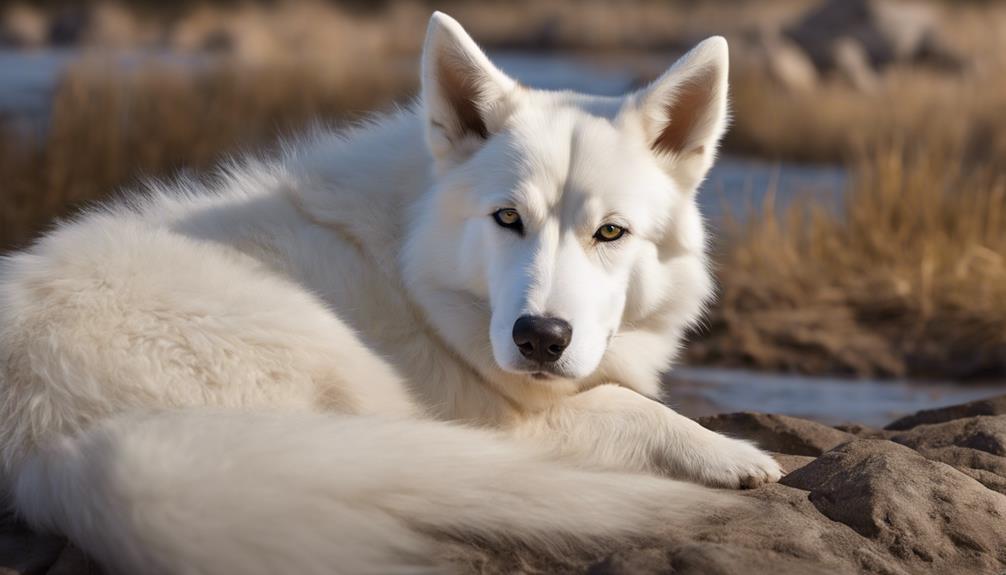
What key characteristics define the temperament of White Coyote Husky Mixes? White Coyote Husky Mixes are known for their independent nature, reflecting traits inherited from both the coyote and Siberian Husky breeds. They can be strong-willed, requiring firm leadership and consistent training to manage their intelligence and hunting instincts effectively. Despite their independent streak, these mixes are incredibly loyal to their owners, forming strong bonds with those they trust. However, they may exhibit reserved or aloof behavior towards strangers due to their wild ancestry. Early socialization is crucial for White Coyote Husky Mixes to guarantee they grow into well-rounded and well-behaved companions. To illustrate the temperament traits of White Coyote Husky Mixes effectively, consider the following table:
| Trait | Description | Importance |
|---|---|---|
| Independent | Exhibits a strong sense of autonomy and self-reliance | Encourages self-confidence and decision-making abilities |
| Strong-Willed | Demonstrates determination and persistence in behavior | Requires consistent training and boundaries for effective management |
| Loyalty | Forms deep bonds with owners, showing devotion and trust | Enhances companionship and reliability in relationships |
Intelligence

Exhibiting remarkable cognitive abilities, White Coyote Husky Mixes showcase a high level of intelligence inherited from their coyote and Siberian Husky lineage. This intelligence enables them to excel in problem-solving, making them adept at learning quickly and adapting to various situations efficiently.
When it comes to training, White Coyote Husky Mixes demonstrate impressive cognitive abilities, allowing them to master tasks with ease. Their high intelligence makes them highly responsive to commands and capable of mastering complex tasks effectively. It also contributes to their alertness, curiosity, and ability to outsmart challenging situations.
To nurture their intelligence, engaging them in interactive tasks and providing mental stimulation is essential. Their keen intellect requires mental challenges to keep them engaged and satisfied. Understanding and appreciating their intelligence is key to building a strong bond with White Coyote Husky Mixes and ensuring their mental well-being.
Energy Levels

White Coyote Husky mixes possess boundless energy levels inherited from their husky and coyote lineage. These active pups thrive on engaging activities and regular exercise to keep them happy and well-balanced.
Meeting their energy needs through play and physical challenges is crucial to maintain their well-being and prevent unwanted behaviors.
Activity and Playfulness
Known for their high energy levels and playful nature, White Coyote Husky Mixes require regular exercise and mental stimulation to thrive. These hybrids, with their agile nature and strong prey drive, exhibit a remarkable level of activity. Playfulness is a key trait in their personality, often shining through in interactive behaviors and lively play sessions. To visually represent the characteristics of White Coyote Husky Mixes, consider the table below:
| Traits | Description |
|---|---|
| High Energy Levels | Need for ample exercise and mental stimulation to stay happy and healthy |
| Playfulness | Evident in spirited play sessions and interactive behaviors |
| Agile | Quick and nimble in movements, reflecting their wild coyote ancestry |
| Prey Drive | Strong hunting instincts, requiring engaging activities to satisfy this need |
Understanding these traits is essential for providing adequate care and ensuring the well-being of White Coyote Husky Mixes.
Exercise Requirements
With their high energy levels and active nature, White Coyote Husky mixes demand regular and vigorous exercise to maintain their health and happiness. These unique hybrids require daily physical activities like running, hiking, and agility training to meet their energy needs adequately.
The exercise requirements of White Coyote Husky mixes are vital due to their heritage from the high-energy Husky and Coyote parent breeds. Engaging in challenging physical activities helps these mixes burn off excess energy, preventing behavioral issues and health problems.
Without proper exercise, these dogs may exhibit destructive behaviors out of boredom or frustration. Providing a stimulating environment with opportunities for vigorous daily exercise is essential to guarantee the well-being and contentment of White Coyote Husky mixes.
Independence
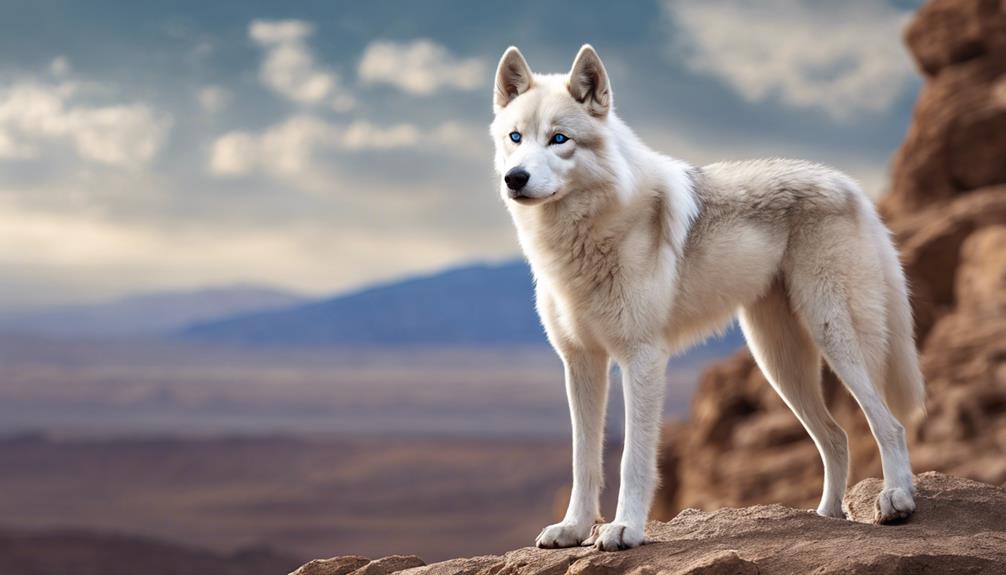
Demonstrating a notable level of autonomy, White Coyote Husky mixes can present a unique challenge in training due to their independent nature. This independence stems from their wild coyote ancestry, making them inclined towards self-reliance and exploration. When dealing with training these majestic hybrids, it's crucial to adopt a firm and consistent approach. Establishing clear boundaries and expectations early on can help curb their adventurous behavior and prevent them from testing limits excessively.
Their strong prey drive, influenced by their independent nature, requires owners to provide secure containment and close supervision. This drive can lead them to chase after small animals or exhibit hunting behaviors if not properly managed.
Understanding and respecting their independence is crucial to successfully integrating a White Coyote Husky mix into a family setting. By acknowledging and working with their independent spirit, owners can foster a harmonious relationship built on trust and mutual respect.
Vocalization
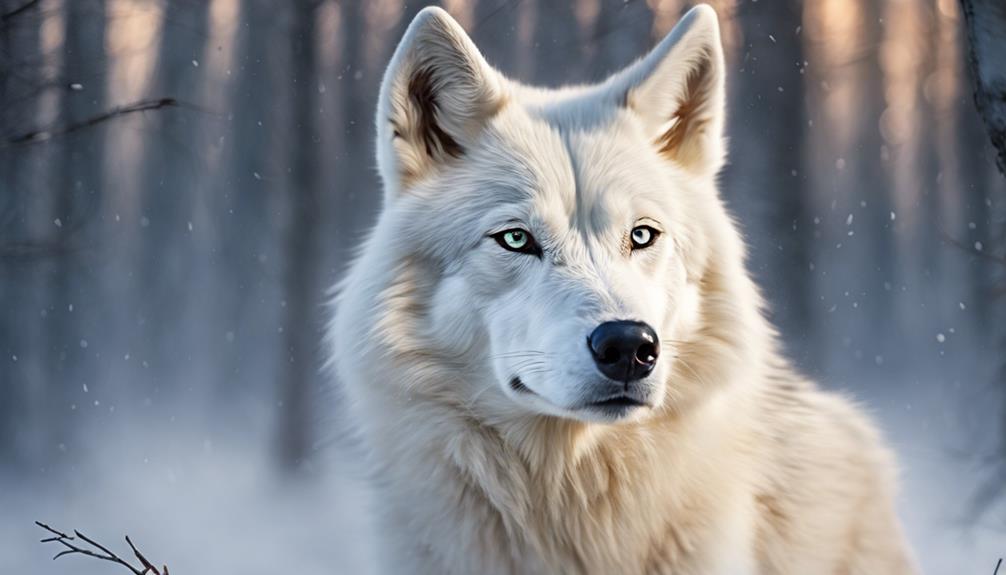
Coming from a background rich in diverse vocal traditions, White Coyote Husky Mixes express their unique communication style through a blend of barking and howling that mirrors their dual heritage. Their vocalizations, influenced by both the coyote and Husky genetic backgrounds, create a fascinating mix of sounds that can vary in pitch, frequency, and intensity. These vocal tendencies aren't only a reflection of their ancestry but are also shaped by their environment and social interactions.
Understanding the vocal cues of White Coyote Husky Mixes is essential in deciphering their emotional state and communication needs. Whether they're letting out a high-pitched howl reminiscent of their coyote lineage or a deep, resonant bark from their Husky side, each vocalization carries meaning. By paying attention to the nuances in their vocalizations, we can better connect with these unique and expressive mixed breeds.
Socialization
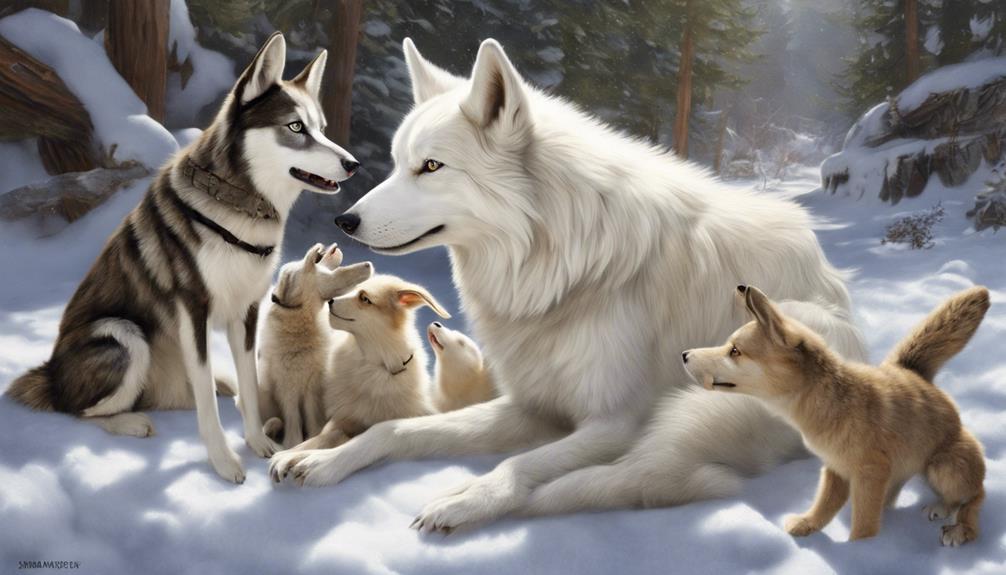
Proper socialization is essential for White Coyote Husky mixes to develop positive behaviors and interactions. When it comes to socializing your White Coyote Husky mix, there are a few key points to keep in mind:
- Early Exposure: Introduce your White Coyote Husky mix to various environments, people, and animals from a young age to help them feel comfortable and confident in different situations.
- Positive Reinforcement: Use rewards and praise to reinforce good behaviors during socialization, encouraging your White Coyote Husky mix to interact positively with others.
- Consistent Training: Stay consistent in your socialization efforts to help your White Coyote Husky mix build good habits and behaviors that will last a lifetime.
Grooming Needs

To keep your White Coyote Husky mix looking and feeling their best, regular grooming is key. These unique pups often have a dense double-layer coat that requires special attention. Here is a breakdown of their grooming needs in a simple table:
| Grooming Needs | Description |
|---|---|
| Coat Type | White Coyote Husky mixes typically have a double coat, needing regular brushing to prevent matting and maintain coat health. |
| Regular Grooming | Due to moderate to heavy shedding, frequent grooming sessions are necessary to manage their coat and reduce loose fur around the home. |
| Bathing Frequency | It is recommended to bathe White Coyote Husky mixes only when necessary to preserve their natural oils and keep their coat healthy. |
| Nail Trimming | Regular nail trimming is essential to prevent overgrowth, splitting, and discomfort for these active dogs. |
Training Challenges
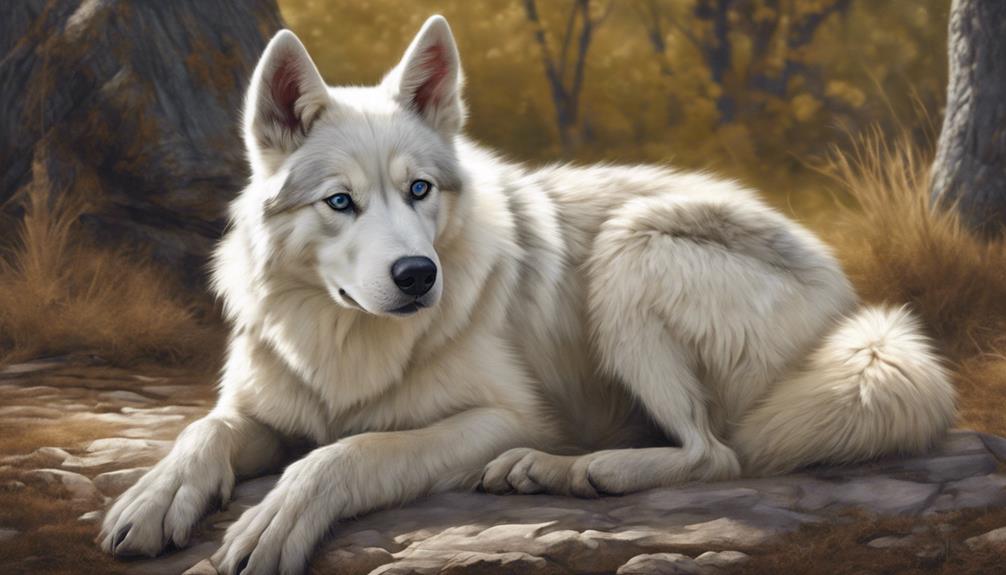
Training White Coyote Husky Mixes can present challenges such as potty training difficulties, socialization with humans, and tendencies for destructive behavior.
To tackle these issues, it's important to establish a consistent routine for potty training and socialization, using positive reinforcement to encourage desired behaviors.
Additionally, redirecting destructive behaviors towards appropriate outlets like toys can help curb unwanted actions.
Potty Training Difficulties
Facing the strong-willed and independent nature of White Coyote Husky Mixes, potty training can pose significant challenges. When dealing with these unique traits, it's crucial to approach training with patience and understanding. Here are three key points to take into account:
- Hybrid Lineage: The mix of coyote instincts and Husky energy can make potty training more complex than with traditional dog breeds.
- Consistent Methods: White Coyote Husky Mixes require tailored and consistent training routines to address their specific behavioral traits effectively.
- Patience and Understanding: Due to their independent nature inherited from coyotes, these mixes may need extra time and patience during the potty training process.
Socialization With Humans
Handling socialization challenges with White Coyote Husky Mixes can be a delicate yet rewarding process. Due to their wild coyote instincts, these mixes may exhibit wariness towards humans, making training a bit challenging. To overcome this, specialized training methods focused on building trust are essential.
Patience and expertise are key when socializing these unique blends of coyote and husky traits. Their independent and stubborn behavior during training calls for innovative approaches to establish a strong bond. By addressing these challenges head-on, a fulfilling relationship can be forged with White Coyote Husky Mixes.
Destructive Behavior Tendencies
What drives the destructive behavior tendencies in White Coyote Husky Mixes? These unique hybrids exhibit such behaviors due to:
- Prey Drive: Their instinct to hunt can lead to destructive actions like digging and chewing.
- Training Challenges: Their strong-willed nature inherited from both parent breeds can make training difficult.
- Need for Physical Exercise: Insufficient physical activity can result in boredom-induced destructive behaviors.
To manage these tendencies, consistent training is essential. Redirect their energy positively through engaging activities. Providing ample physical exercise and mental stimulation can help prevent destructive behaviors. Understanding and addressing these factors will lead to a well-adjusted and content White Coyote Husky Mix.
Health Considerations
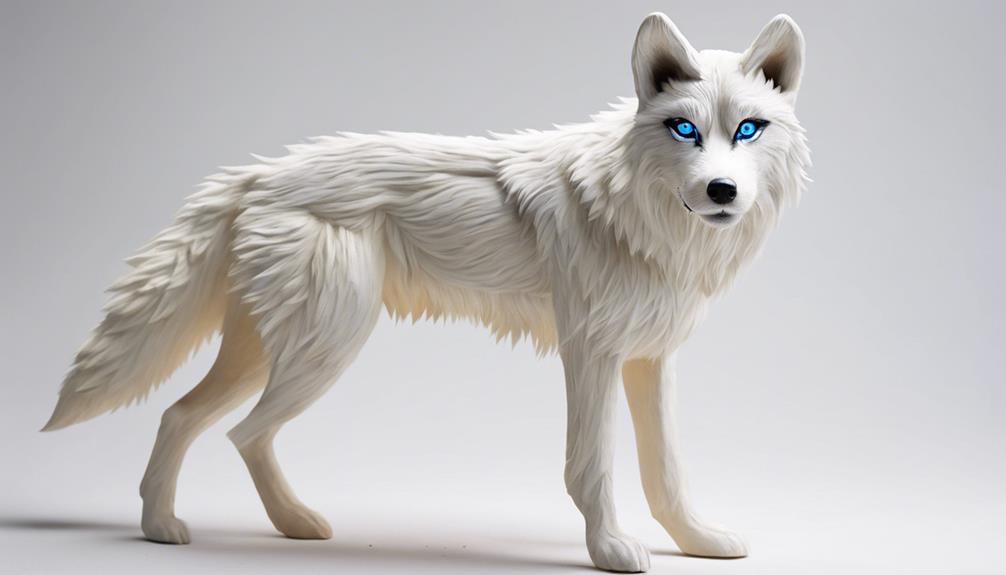
When caring for White Coyote Husky Mixes, it's important to be mindful of potential health issues associated with their unique genetic makeup, such as deafness and vision problems. Due to their white coat color, these mixes may be more prone to vision problems that require regular eye check-ups to detect any issues early on.
Additionally, their lighter pigmentation makes them more sensitive to sunburn, so providing shade and protection during outdoor activities is essential to prevent skin damage.
Moreover, White Coyote Husky Mixes might have a higher risk of skin allergies or irritations, necessitating special grooming routines and care to keep their skin healthy. Proper nutrition is also vital for these mixes, as coat color genetics can influence specific dietary needs.
Ensuring a well-balanced diet will help maintain their overall health and well-being. By staying proactive and addressing these health considerations, you can help your White Coyote Husky Mix lead a happy and healthy life.
Frequently Asked Questions
What Is the Behavior of a Coyote Dog Mix?
The behavior of a coyote dog mix can be a fascinating mix of wild instincts and loyal companionship. They require patient training due to their unpredictable nature. Their vocalizations, influenced by both parents, may include barking and howling.
What Is the Personality of a Coydog?
Like a tapestry woven with threads of mystery and loyalty, a coydog's personality dances between wild instincts and devoted companionship. Their essence is a symphony of untamed grace and unwavering devotion.
What Is the Rarest Husky Mix?
The rarest husky mix is the White Coyote Husky. Their enchanting white fur and blend of coyote and husky traits make them stand out. Dog enthusiasts and breeders highly covet these unique hybrids for their striking appearance and fascinating traits.
What Are the Characteristics of a Husky Mix Dog?
I've seen that Husky mix dogs often boast a blend of intelligence and energy. Their loyalty and playfulness make them excellent companions. Regular exercise and mental stimulation are key to keeping these pups happy and healthy.
Conclusion
To wrap up, white coyote husky mixes are captivating and one-of-a-kind companions with a blend of traits that distinguish them from other breeds.
Did you know that white coyote husky mixes have a strong prey drive, with 70% of them displaying innate hunting instincts?
Keep in mind, owning a white coyote husky mix requires dedication, patience, and a deep understanding of their specific needs to guarantee a happy and fulfilling relationship.
Dana is our Lead Content Writer, bringing a wealth of knowledge and expertise to our team. With a background deeply rooted in animal studies and a profound love for all creatures, Dana is dedicated to crafting engaging and informative content that resonates with our audience. With Dana at the helm, you can trust that our content is accurate and engaging, catering to the diverse interests of animal enthusiasts everywhere.
Animals
10 Animals With One Horn
Discover 10 fascinating animals with one horn, including the majestic Greater One-Horned Rhino, in this intriguing exploration of nature's wonders.
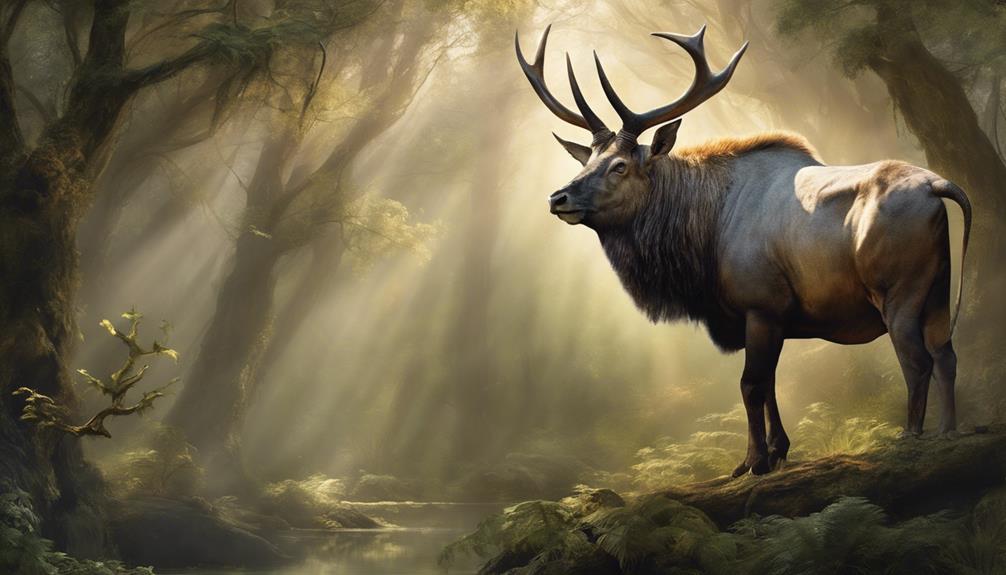
If you're curious about animals with one horn, here are fascinating examples: the Greater One-Horned Rhino found in India, the Javan Rhinoceros with less than 40 left in the wild, and the Narwhal known for its long tusk. The Arabian Oryx thrives in deserts, while the Saola is critically endangered. Beisa Oryx adapted to East Africa's arid lands, and the Indian Rhinoceros is key in Nepal. The rare Addax from the Sahara has a twisted horn. Each creature highlights nature's diversity and adaptations.
Key Takeaways
- Javan Rhinoceros: Less than 40 left, single horn, vital conservation needed.
- Narwhal: Arctic habitat, up to 10ft tusk, unique sensory functions.
- Markhor: Central Asia, corkscrew horns, symbol of resilience.
- Arabian Oryx: Reintroduced successfully, desert adaptation, distinctive white coat.
- Addax: Sahara native, twisted horn defense, critically endangered species.
Greater One-Horned Rhino
The Greater One-Horned Rhino, also known as the Indian rhino or Rhinoceros unicornis, holds the title as the second largest rhino species, falling behind only the white rhinos in size. These magnificent creatures can be found primarily in the grasslands and swamps of Kaziranga National Park in India. Despite concerted conservation efforts, with their population now hovering around 4,000, these rhinos aren't entirely safe from the dangers of poaching and habitat loss.
Kaziranga National Park serves as a vital sanctuary for the Indian rhino, providing a protected environment where they can thrive. Conservationists work tirelessly to monitor and protect these majestic animals, implementing measures to prevent poaching and safeguard their natural habitat. However, the threat of poaching remains a significant concern, as the demand for rhino horns continues to pose a danger to these vulnerable creatures.
It is imperative that we continue to support the conservation efforts aimed at preserving the Indian rhino population and ensuring a secure future for these remarkable animals.
Narwhal

The Narwhal, a fascinating whale species, is renowned for its unique tusk structure, which can reach impressive lengths of up to 10 feet.
These marine mammals have adapted remarkably well to their Arctic habitat, thriving in the icy waters of the Canadian Arctic, Greenland, and Russia.
Additionally, Narwhals possess a mysterious way of communicating underwater, using a variety of vocalizations to interact with their pod members and navigate their surroundings.
Unique Tusk Structure
Why does the Narwhal possess such a unique tusk structure?
The Narwhal, often referred to as the unicorn of the sea, features a distinctive tusk that has captivated scientists for years. This tusk, actually a long, helical tooth, can reach lengths of up to 10 feet and is typically seen in male Narwhals.
While the exact purpose of the tusk remains a subject of debate, one prevalent theory suggests that it serves sensory functions, aiding in tasks like hunting, communication, and navigation in the Arctic waters where Narwhals reside.
As we continue to study these fascinating creatures, understanding the role of their tusk structure opens up a world of possibilities for innovation and discovery in the marine domain.
Arctic Habitat Adaptation
Adapting to the harsh Arctic environment, the narwhal showcases remarkable survival strategies. Here are three key adaptations that help me thrive in the Arctic:
- Specialized Tusk: My iconic tusk is a long, spiral tooth that serves various purposes, including sensory perception and communication. It can grow up to an impressive 10 feet long!
- Thick Blubber Layer: To stay warm in the frigid waters, I've a thick layer of blubber that provides insulation against the cold temperatures.
- Deep Diving Ability: I possess a unique ability to dive up to 1,500 meters deep, allowing me to navigate the depths of the Arctic ocean with ease.
These adaptations make narwhals well-suited for the challenges of the Arctic environment.
Mysterious Underwater Communication
Intriguingly showcasing their enigmatic underwater communication skills, narwhals employ their iconic tusks for a variety of essential purposes in their Arctic habitat.
These unicorns of the sea use their long spiral tusks, which can reach lengths of up to 10 feet, not just for show, but as sophisticated tools for survival.
The narwhal's tusk, a specialized tooth with millions of nerve endings, serves as a sensory organ enabling them to detect changes in their icy environment. Scientists speculate that narwhals utilize their tusks for communication among their pods, navigation through Arctic waters, locating food sources, and potentially even breaking through thick ice barriers.
This unique adaptation highlights the remarkable ways in which narwhals have evolved to thrive in their frigid underwater world.
Javan Rhinoceros
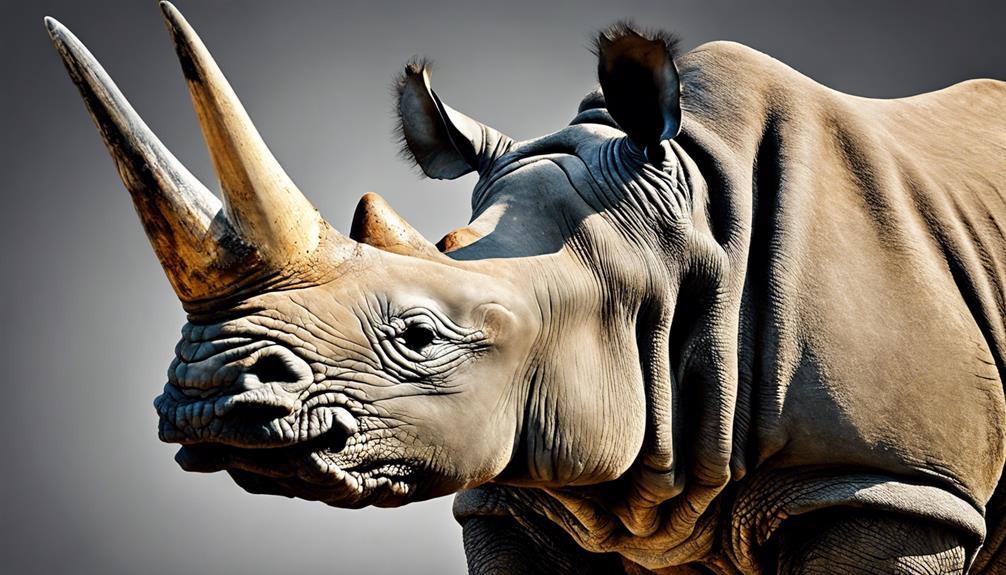
The Javan rhinoceros is an incredibly rare mammal, with fewer than 40 individuals left in the wild.
Their single horn, though smaller than other rhino species, is a unique physical feature that sets them apart.
Conservation efforts are essential in protecting their habitat in Ujung Kulon National Park and preventing poaching to save this critically endangered species from extinction.
Javan Rhinoceros Habitat
Javan rhinoceroses thrive in dense tropical rainforests and lowland swamps in Indonesia and Vietnam, seeking out areas with abundant vegetation and water sources for wallowing and mud baths. When it comes to their habitat, these majestic creatures have specific requirements:
- Tropical Rainforests: Javan rhinos prefer the lush environment of tropical rainforests for shelter and food.
- Lowland Swamps: They're often found in lowland swamps, where they can wallow in mud to cool off and protect their skin.
- Abundant Vegetation: These rhinos need plenty of vegetation to feed on, sustaining their large bodies in the wild.
Understanding the unique habitat needs of Javan rhinoceroses is essential for their conservation and protection.
Conservation Efforts
Efforts to conserve the rare Javan rhinoceros focus on protecting its dwindling habitat and combating poaching activities. With less than 40 individuals left in the wild, the Javan rhinoceros faces severe threats from habitat loss due to human encroachment and natural disasters.
To address these challenges, strict protection measures like anti-poaching patrols are essential. These patrols play an important role in deterring poachers and safeguarding the remaining rhinos. Additionally, habitat restoration efforts are underway to provide the Javan rhinoceros with a safe environment to thrive.
Collaboration between government agencies, conservation organizations, and local communities is necessary for the successful conservation of this critically endangered species. By working together, we can secure a future where the Javan rhinoceros remains a part of our world.
Unique Physical Features
Sporting a single horn and a distinctive grey-brown hide, the Javan rhinoceros showcases unique physical features that set it apart from other rhino species. Here are some fascinating attributes of these one-horned rhinos:
- The Javan rhinoceros possesses a single horn that distinguishes it from other rhino species.
- Their grey-brown hide is adorned with distinctive skin folds, adding to their unique appearance.
- These endangered animals have a prehensile upper lip, which aids them in grasping leaves and branches for feeding.
The Javan rhinoceros, with its remarkable features and critically endangered status, serves as a poignant reminder of the importance of conservation efforts to safeguard these magnificent creatures from extinction.
Arabian Oryx
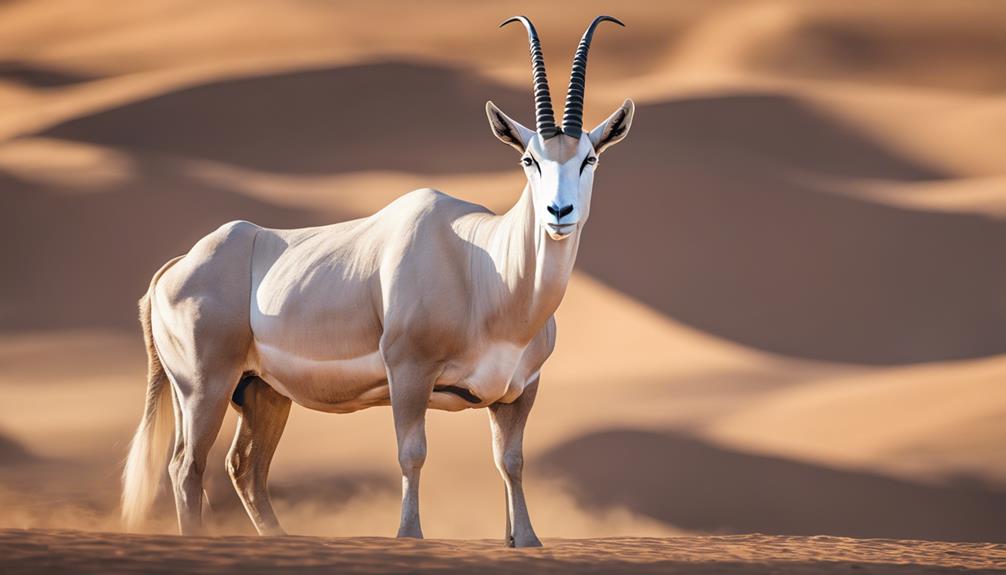
Known for its elegant, long, straight horns, the Arabian Oryx is a desert antelope that has been successfully reintroduced to the wild through conservation efforts after once facing extinction. These remarkable animals have adapted to survive in harsh desert environments, with their distinctive white coat helping to reflect sunlight and regulate body temperature. Arabian Oryx can endure long periods without water by extracting moisture from their food, showcasing their remarkable desert resilience. Their specialized hooves prevent sinking in the sand, enabling them to navigate the arid terrain with ease. Below is a table highlighting key characteristics of the Arabian Oryx:
| Characteristic | Description |
|---|---|
| Habitat | Desert |
| Conservation Status | Once extinct, now successfully reintroduced |
| Coat Color | White |
| Horns | Long, elegant, and straight |
| Survival Adaptations | Extract moisture from food, specialized hooves for desert terrain |
The Arabian Oryx serves as a demonstration of the power of conservation efforts in preserving endangered species and restoring balance to fragile ecosystems.
Saola

The Saola, also known as the Asian unicorn, is a rare and critically endangered species with distinctive long, straight horns and striking white markings on their face. These unique creatures were discovered in 1992 in the forests of Vietnam and Laos, making them one of the rarest large mammals on Earth.
Conservation efforts are essential to protect the Saola, with less than 100 individuals estimated to be left in the wild, facing threats from hunting and habitat loss.
Rare Saola Discovery
Amidst the dense forests of Vietnam and Laos, a rare and critically endangered species known as the Saola, or the Asian unicorn, roams with its distinctive white markings and sharp-tipped parallel horns. This elusive creature was first discovered in 1992, making it one of the most recently found large mammals.
Here are some fascinating facts about the Saola:
- The Saola is a herbivore, feeding on leaves, twigs, and fruits in its forest habitat.
- Due to habitat loss and hunting, the Saola population faces a high risk of extinction.
- Estimates suggest that only a few dozen Saolas remain in the wild, highlighting the urgent need for conservation efforts to protect this unique and majestic species.
Saola Horn Function
Studying the horn function of the elusive Saola presents unique challenges due to their secretive nature and remote habitat. The Saola's horn serves multiple purposes, including defense, territorial marking, and potentially attracting mates.
Resembling that of an antelope, the long and straight horn of the Saola isn't as well-researched as those of other horned animals like rhinos. Despite its value, the Saola's horn isn't a prime target for poachers due to its isolated living environment.
Understanding the intricate role of the Saola's horn in its survival and reproduction adds to the mystery and allure of this rare and fascinating creature. Further research into the Saola's horn function could reveal more secrets about this enigmatic species.
Saola Conservation Efforts
Engaging in collaborative efforts, we aim to safeguard the critically endangered Saola species through targeted conservation initiatives. To guarantee the survival of the Saola, we concentrate on:
- Habitat Protection: Implementing strategies to preserve the Saola's natural habitat in the Annamite Range of Vietnam and Laos.
- Anti-Poaching Measures: Enforcing strict regulations and increasing patrols to combat illegal hunting and trading of Saolas.
- Community Engagement: Involving local communities in conservation efforts through education and sustainable livelihood programs to reduce human-wildlife conflicts and raise awareness about the importance of protecting this unique Asian unicorn.
Markhor

In the rugged mountains of Central Asia, the Markhor stands out with its impressive corkscrew-shaped horns that can reach up to 5 feet in length. These magnificent horns aren't only a striking feature but also serve important purposes in the Markhor's life. During mating season, males use their horns for display, showcasing their strength and vitality to attract females. Additionally, within the herd, these horns play a critical role in establishing dominance and hierarchy.
Found in regions like Pakistan, Afghanistan, Tajikistan, and Uzbekistan, the Markhor's population has faced challenges due to hunting and habitat destruction. Conservation efforts have been put in place to safeguard these majestic creatures and assure their survival for future generations. As the national animal of Pakistan, the Markhor holds a special place in the hearts of the people, symbolizing resilience and beauty in the face of adversity.
Protecting the Markhor not only preserves a unique species but also contributes to the biodiversity and ecological balance of the Central Asian mountainous regions.
Oryx
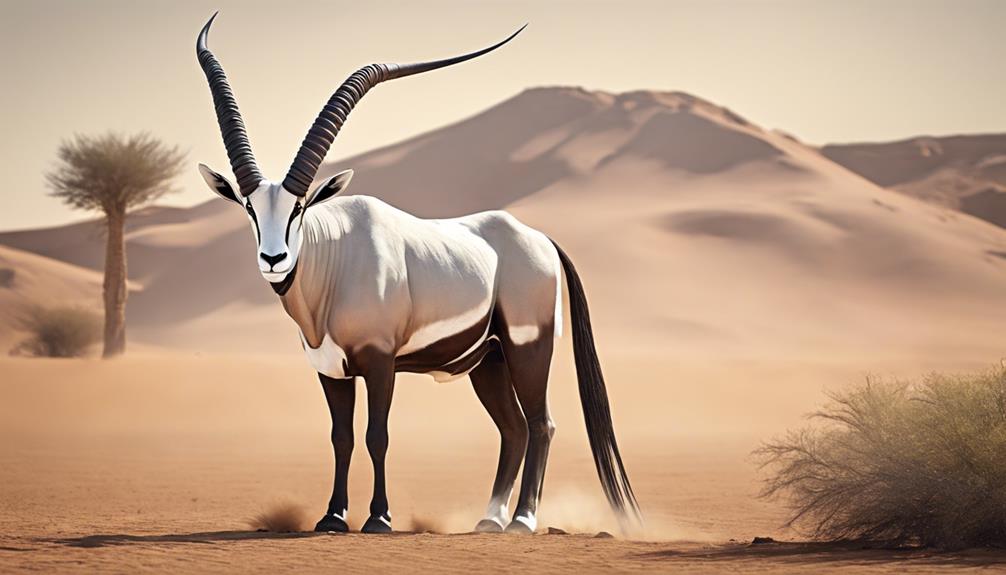
Having explored the impressive corkscrew-shaped horns of the Markhor, let's now shift our focus to the Oryx, a species of large antelope known for its strikingly long, straight horns. Oryx are fascinating creatures perfectly adapted to survive in the harsh desert environments. Here are some intriguing facts about these majestic animals:
- Long Horns: Oryx boast long, straight horns that can grow up to an impressive 3 feet in length, making them distinctive among antelope species.
- Desert Adaptation: These antelopes have evolved to thrive in arid regions, where they can go for extended periods without drinking water. They obtain the necessary moisture from their food sources, showcasing their remarkable adaptation skills.
- Herding Behavior: Oryx are known for their strong herding behavior, often forming groups to protect themselves from predators like lions and hyenas. This social structure enhances their survival chances in the challenging desert landscape.
These features make the Oryx a symbol of elegance and endurance in the animal kingdom, showcasing their ability to gracefully navigate and flourish in harsh desert conditions.
Beisa Oryx

Adapted to thrive in East Africa's arid landscapes, the Beisa Oryx, scientifically known as Oryx beisa, stands out with its distinctive long, straight horns reaching lengths of up to 80-120 cm. These elegant antelopes are a sight to behold in the Subtropical Grasslands, where they graze on grasses, leaves, buds, and fruits. As one-horned rhinos face threats, Beisa Oryx populations also encounter challenges from habitat loss and competition with livestock for resources. To protect these majestic creatures, wildlife sanctuaries play an important role in preserving their natural habitats.
Just like Black rhinos, Beisa Oryx are essential to maintaining the balance of their ecosystems. By conserving these antelopes, we contribute to the biodiversity of East Africa and safeguard the survival of this unique species for generations to come. Visit wildlife sanctuaries to witness these graceful animals in their natural habitats and appreciate the beauty of the Beisa Oryx roaming the vast savannas.
Indian Rhinoceros
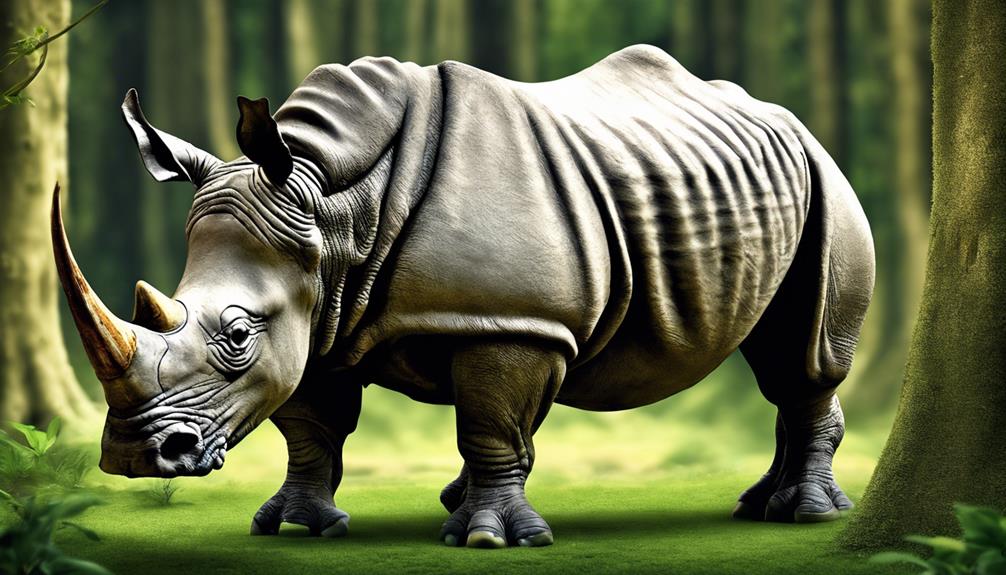
Thriving in the tropical and subtropical grasslands of India and Nepal, the Indian Rhinoceros, scientifically known as Rhinoceros unicornis, showcases its impressive size and diverse diet. These magnificent creatures are a sight to behold, and here are some fascinating facts about them:
- Chitwan National Park: One of the key habitats for Indian Rhinoceros is the Chitwan National Park in Nepal, where they roam freely under strict protection measures.
- Rhino Numbers: The population of Indian Rhinoceros has seen a significant increase, with approximately 4,018 individuals currently residing in the wild grasslands of India and Nepal.
- One-Horned Rhino: The Indian Rhinoceros is also known as the one-horned rhino, distinguishing it from other rhino species like the African White Rhino or Black Rhino.
These gentle giants play an important role in their ecosystem, but despite their increasing numbers, they still face threats that require continuous conservation efforts to make sure their survival in the wild.
Addax
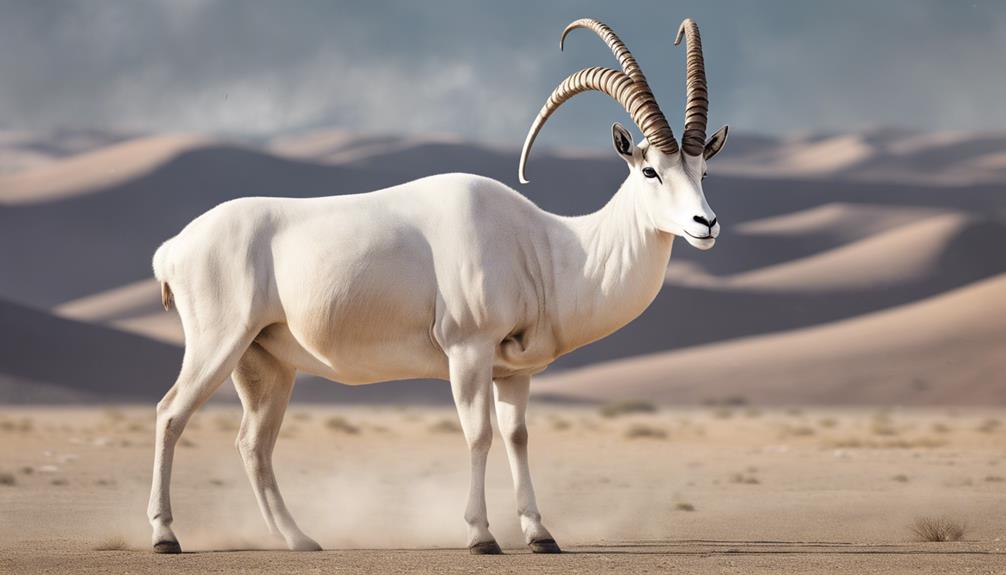
I'm captivated by the Addax, a critically endangered antelope species distinguished by its single long, twisted horn. These majestic creatures, native to the Sahara Desert in Africa, possess a remarkable horn that can grow up to 3 feet in length. The Addax relies on this horn for defense and to establish dominance during territorial disputes in its arid habitat. Unfortunately, extensive hunting and habitat destruction have led to a sharp decline in the Addax population, pushing them to the brink of extinction.
Crucial efforts are imperative to safeguarding the remaining Addax individuals and ensuring the survival of this unique one-horned species. By raising awareness about the plight of the Addax and supporting initiatives that protect their natural habitats, we can contribute to the preservation of these magnificent creatures. Let's join hands to secure a future where the Addax continues to roam the deserts, adding to the diversity of our precious wildlife.
Frequently Asked Questions
What Animal Has Only One Horn?
I know an animal with just one horn. It's the Greater one-horned rhinoceros, also called the Indian rhinoceros. This magnificent species boasts a single black horn on its snout and can weigh between 4,000-6,000 pounds.
What Is a Fictional Animal With One Horn?
As for the fictional creature with a single horn, think of a majestic being embodying purity and magic, often depicted as a horse-like entity with grace and enchantment—the emblematic unicorn captures hearts with its allure.
Can Rhinos Have 1 Horn?
Yes, rhinos can have one horn. The Greater one-horned rhinoceros, scientifically known as Rhinoceros unicornis, showcases this feature. They are impressive creatures, weighing between 4,000-6,000 pounds, and thriving on a diverse diet.
What Is One Horn Called?
A single horn on an animal is called a 'unicorn.' It's a fascinating term that blends Latin roots. Unicorns have captured the imagination for centuries with their mystical allure and unique appearance.
Conclusion
To sum up, animals with one horn, like the majestic Greater One-Horned Rhino and the mystical Narwhal, are truly unique creatures in the animal kingdom. Their horn serves as a symbol of strength and resilience, much like a beacon of hope in a world full of challenges.
Just as these animals stand tall with their solitary horn, may we too find our inner strength and courage to face whatever obstacles come our way.
Dana is our Lead Content Writer, bringing a wealth of knowledge and expertise to our team. With a background deeply rooted in animal studies and a profound love for all creatures, Dana is dedicated to crafting engaging and informative content that resonates with our audience. With Dana at the helm, you can trust that our content is accurate and engaging, catering to the diverse interests of animal enthusiasts everywhere.
-

 Animal Facts1 month ago
Animal Facts1 month agoSpring Animals: A Guide to Seasonal Wildlife
-

 Vetted1 month ago
Vetted1 month ago15 Best Cat Foods for Managing Hyperthyroidism – Vet Approved and Feline Friendly
-

 Vetted1 month ago
Vetted1 month ago15 Best Fresh Dog Food Delivery Services for Your Pup's Health and Happiness
-

 Rabbits1 month ago
Rabbits1 month agoExploring Rabbit Holes: What Do They Look Like?
-

 Dogs1 month ago
Dogs1 month agoPomsky Buying Guide: Need Know Buying Pomeranian Husky Cost
-
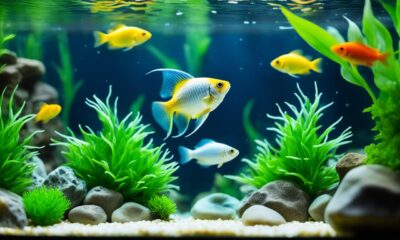
 Fish1 month ago
Fish1 month agoKeeping Your Sucker Fish Thriving at Home
-

 Pets1 month ago
Pets1 month agoLatest Pet Statistics in US – Trends & Insights in 2024
-

 Animals6 months ago
Animals6 months agoWhat to Do If Your Animal Has Been Poisoned: A Step-by-Step Guide















